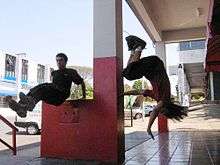Freerunning
 Brazilian freerunners move fluidly through urban environment | |
| Also known as | Free running and/or FR |
|---|---|
| Country of origin | France |
| Creator | David Belle, Sebastien Foucan |
| Famous practitioners |
Daniel Ilabaca Ryan Doyle, Tim Shieff, Luci Romberg, Sebastien Foucan |
| Ancestor arts | Parkour |
| Olympic sport | Not currently; IOC discussions underway[1] |
| Meaning | A version of Parkour that includes acrobatic movements that are purely aesthetic. |
Freerunning (or free running/FR) is an acrobatic and athletic discipline founded by Sébastien Foucan, who wrote a book on the subject. Foucan started what he termed "freerunning" in 2003, which he developed as a more inclusive form of parkour.[2] Parkour's development from military obstacle course training lends itself to martial art as a means of weapons avoidance and efficiently closing a distance to an opponent. Freerunning is a version of parkour that adds acrobatic moves that are purely aesthetic, also known as tricking.
Etymology
The word "freerunning" was first used in the documentary, Jump London.[3] The name came about because of a suggestion by Guillaumme Pelletier, who was working with Foucan at the time. The reasoning behind the name was, to quote Foucan, "'Free' because it's free, and just 'running'."[3] In the documentary, freerunning was defined as an English translation of parkour.[4]
| Look up freerunning in Wiktionary, the free dictionary. |
| Wikimedia Commons has media related to Freerunning. |
Philosophy
The central principle of freerunning is that one should express oneself by moving fluidly in one's environment; there are no limitations on the form of this movement.[5] Foucan expands on a number of basic principles of the sport in his book, Freerunning.[5] Other practitioners have suggested other principles. For example, Daniel Ilabaca encourages people to think positively, suggesting that practitioners of freerunning will sometimes fall—largely because they think they might.[6]
History
Origins in parkour
In Western Europe the idea of moving past obstacles for personal development or sport originated with Georges Hébert.[7] He observed untrained native tribes in Africa with fantastic athletic ability and created the 'natural method' system to train people using the same ideas. His ideas eventually led to the parcours du combattant ('obstacle course', literally 'assault course'), which is now a standard of military training.[8]
| Wikiversity has learning resources about Parkour and Freerunning |
These ideas were picked up by a young Raymond Belle, who used them to practical effect while separated from his family during the First Indochina War. When he moved to France and started a family, he passed on these ideas to his son, David. 30 years later, other young people were attracted to these ideas and a small group formed, the Yamakasi, which included Foucan.[7][9] This group trained together for several years and in 1997, through David Belle's brother, Jean-Francois, they started to attract attention and be invited to perform at events. The Yamakasi eventually split apart, though, because some members sought to find more individual expressions of the discipline.[10][11] Meanwhile, action star Jackie Chan had also been heavily incorporating the same concepts in most of his films ever since the early 1980s from the other side of the globe.[12]
Further development
Foucan wanted to create a discipline that was more personal to the individual than parkour and more easily adapted to suit each person's individual goals.[5] His idea was similar to that of Bruce Lee's creation of Jeet Kune Do. Foucan wanted to take everything that he had found useful and that he liked from his parkour experiences and combine it into one sport.[3]
Foucan's early ideas were first spread through the Jump London documentary (2003) and its sequel, Jump Britain (2005). Foucan has appeared in other productions, such as Casino Royale and Madonna's Confessions Tour.[10] With each appearance both the discipline and Foucan himself increased in fame.[5]
International
In 2014, the BBC traveled to Indian administered Kashmir[13] to highlight the youth partaking in freerunning as a form of freedom of expression.
References
- ↑ "PARKOUR – A YOUNG SPORT WITH OLYMPIC AMBITIONS". European Olympic Committees.
- ↑ "Parkour" World Freerunning Parkour Federation. Retrieved 2015-5-7.
- 1 2 3 Foucan, Sebastien (28 October 2012). "Sebastien Foucan – Find your way – London Real". London Real (Interview). London. Retrieved 3 July 2013.
- ↑ Note: Foucan has since said that the confusion regarding the roots of the term came out of the fact that he was still formulating his ideas at the time of the filming.
- 1 2 3 4 Foucan, Sebastien (2008). Freerunning. U.K.: Michael O'Mara Books. p. 8. ISBN 978-1-56975-652-2.
- ↑ Declan Saldana (27 January 2012). "Parkour Legends: Daniel Ilabaca, Tim Shieff and Oleg Vorslov". Retrieved 3 July 2013.
- 1 2 Edwardes, Dan (22 August 2014). "Parkour History". ParkourGenerations.com. Retrieved 12 June 2015.
- ↑ "George Hébert and the Natural Method of Physical Culture". Archived from the original on 23 March 2005. Retrieved 3 July 2013.
- ↑ Belle, David (2009). Parkour. Intervista. pp. 31–70. ISBN 978-2-35756-025-3.
- 1 2 Angel, Julie (2011). Ciné Parkour. pp. 17–20. ISBN 978-0-9569717-1-5.
- ↑ Belle, David (2009). Parkour. Intervista. pp. 71–79. ISBN 978-2-35756-025-3.
- ↑ "Jackie Chan's Special Style Of Parkour". Parkour and Freerunning Online: Your source of Parkour and Freerunning videos. November 5, 2015. Archived from the original on 2016-03-04.
- ↑ "Kashmir Freerunning Finding Freedom in the Art of Parkour". BBC. 7 December 2014.